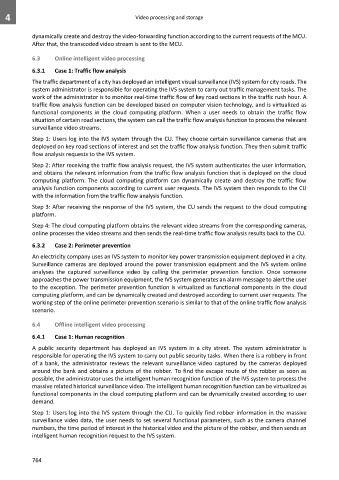Page 772 - Cloud computing: From paradigm to operation
P. 772
4 Video processing and storage
dynamically create and destroy the video-forwarding function according to the current requests of the MCU.
After that, the transcoded video stream is sent to the MCU.
6.3 Online intelligent video processing
6.3.1 Case 1: Traffic flow analysis
The traffic department of a city has deployed an intelligent visual surveillance (IVS) system for city roads. The
system administrator is responsible for operating the IVS system to carry out traffic management tasks. The
work of the administrator is to monitor real-time traffic flow of key road sections in the traffic rush hour. A
traffic flow analysis function can be developed based on computer vision technology, and is virtualized as
functional components in the cloud computing platform. When a user needs to obtain the traffic flow
situation of certain road sections, the system can call the traffic flow analysis function to process the relevant
surveillance video streams.
Step 1: Users log into the IVS system through the CU. They choose certain surveillance cameras that are
deployed on key road sections of interest and set the traffic flow analysis function. They then submit traffic
flow analysis requests to the IVS system.
Step 2: After receiving the traffic flow analysis request, the IVS system authenticates the user information,
and obtains the relevant information from the traffic flow analysis function that is deployed on the cloud
computing platform. The cloud computing platform can dynamically create and destroy the traffic flow
analysis function components according to current user requests. The IVS system then responds to the CU
with the information from the traffic flow analysis function.
Step 3: After receiving the response of the IVS system, the CU sends the request to the cloud computing
platform.
Step 4: The cloud computing platform obtains the relevant video streams from the corresponding cameras,
online processes the video streams and then sends the real-time traffic flow analysis results back to the CU.
6.3.2 Case 2: Perimeter prevention
An electricity company uses an IVS system to monitor key power transmission equipment deployed in a city.
Surveillance cameras are deployed around the power transmission equipment and the IVS system online
analyses the captured surveillance video by calling the perimeter prevention function. Once someone
approaches the power transmission equipment, the IVS system generates an alarm message to alert the user
to the exception. The perimeter prevention function is virtualized as functional components in the cloud
computing platform, and can be dynamically created and destroyed according to current user requests. The
working step of the online perimeter prevention scenario is similar to that of the online traffic flow analysis
scenario.
6.4 Offline intelligent video processing
6.4.1 Case 1: Human recognition
A public security department has deployed an IVS system in a city street. The system administrator is
responsible for operating the IVS system to carry out public security tasks. When there is a robbery in front
of a bank, the administrator reviews the relevant surveillance video captured by the cameras deployed
around the bank and obtains a picture of the robber. To find the escape route of the robber as soon as
possible, the administrator uses the intelligent human recognition function of the IVS system to process the
massive related historical surveillance video. The intelligent human recognition function can be virtualized as
functional components in the cloud computing platform and can be dynamically created according to user
demand.
Step 1: Users log into the IVS system through the CU. To quickly find robber information in the massive
surveillance video data, the user needs to set several functional parameters, such as the camera channel
numbers, the time period of interest in the historical video and the picture of the robber, and then sends an
intelligent human recognition request to the IVS system.
764

